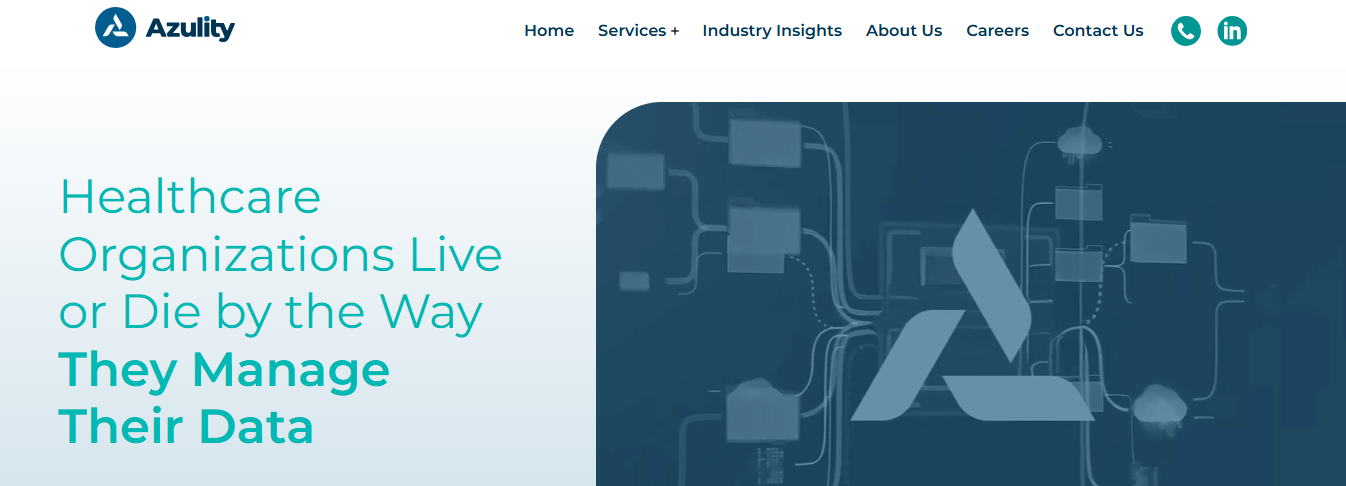Consider a hospital that treats hundreds of patients daily and conducts countless tests and procedures. Each activity generates data that must be organized and stored for easy access. Without a solid healthcare data architecture, the hospital may struggle to piece together vital information about a patient’s medical history, even if that data is available in the system.
The consequences of such a scenario can be dire. Implementing an efficient healthcare data architecture can help healthcare organizations avoid these challenges. This guide will explain how to create a robust data architecture to optimize healthcare data management and improve patient outcomes.
Azulity’s healthcare master data management services can help you achieve your goals by creating a reliable and organized structure for your healthcare data. With a solid architecture, you can streamline healthcare data management and improve access to critical information to deliver quality patient care.
What Is Healthcare Data Architecture

Healthcare data architecture is the framework for collecting, storing, managing, and using health-related data across healthcare organizations and systems. This architecture provides a structured way to integrate diverse data sources, including patient records, diagnostic images, lab results, and administrative data, into a centralized system that supports analysis, reporting, and clinical decision-making.
The Components of Healthcare Data Architecture
Healthcare data architecture consists of several components, each with an important role. These include:
Data Sources and Collection
This involves various inputs, such as electronic health records (EHRs), laboratory systems, imaging data, and wearable devices. Data is collected from hospitals, clinics, pharmacies, insurance companies, and patients.
Data Integration and Interoperability
Ensuring that different systems can communicate and share data is crucial. This includes HL7, FHIR, and other standards to support interoperability between health systems.
Data Storage and Management
Healthcare data must be stored in secure and compliant environments. Standard solutions include cloud-based data lakes, on-premises databases, and hybrid storage models that allow easy access while meeting privacy standards like HIPAA.
Data Security and Compliance
Protecting patient data from unauthorized access is critical. This involves encryption, access control, and compliance with HIPAA, GDPR, and HITECH regulations.
Analytics and Data Processing
Tools and platforms for data analytics, machine learning, and AI process and analyze healthcare data. The insights derived can support clinical decisions, improve operational efficiency, and help in predictive healthcare.
User Access and Interface
To make data usable, healthcare data architectures often include dashboards, reporting tools, and interfaces that allow doctors, administrators, and other healthcare professionals to access and interpret data effectively.
Related Reading
- Data Quality Management in Healthcare
- How to Secure Patient Data
- Master Data Management Solutions
- Patient Data Management System
Layers of Healthcare Data Architecture


Gathering Raw Data: Data Ingestion Layer
The data ingestion layer is responsible for collecting raw data from various sources. These sources include electronic health records (EHRs), lab systems, radiology systems, patient wearables, IoT devices, administrative systems, and external data sources (such as insurance). The incoming data is validated, cleaned, and transformed to ensure quality and consistency for further processing.
Ensuring Smooth Data Flow: Data Integration and Interoperability Layer
The data integration and interoperability layer ensures smooth data flow between systems and applications. Key components include interoperability standards (e.g., HL7, FHIR, DICOM), APIs, middleware, and ETL (Extract, Transform, Load) tools. This layer harmonizes data from disparate sources into a unified format, enabling data exchange across various healthcare systems and supporting regulatory requirements for interoperability.
Storing Data Securely: Data Storage Layer
The data storage layer provides secure and scalable storage for healthcare data. The main components include data lakes, warehouses, cloud storage, and on-premises databases. This layer stores structured (e.g., patient demographics) and unstructured data (e.g., medical imaging, clinical notes) in compliant, secure environments. Backup and disaster recovery solutions are often included to ensure data availability and resilience.
Transforming Data Into Insights: Data Processing and Analytics Layer
The data processing and analytics layer transforms stored data into actionable insights. Components include big data analytics tools, machine learning and AI algorithms, natural language processing (NLP) tools, and visualization platforms. This layer analyzes patient data to support clinical decision-making, improve healthcare operations, and enable predictive analytics. It is essential for research, population health management, and personalized medicine.
Protecting Sensitive Information: Data Security and Compliance Layer
The data security and compliance layer protects sensitive healthcare information and ensures regulatory compliance. Key components include encryption tools, access control systems, audit trails, and compliance frameworks (e.g., HIPAA, GDPR). This layer manages data access, monitors unauthorized activities, and enforces privacy policies. It is critical for safeguarding patient data against breaches and ensuring compliance with healthcare regulations.
Making Data User-Friendly: Data Access and Presentation Layer
The data access and presentation layer provides a user-friendly interface for accessing and visualizing data. Key components include dashboards, reporting tools, mobile apps, and web portals. This layer enables healthcare providers, administrators, and researchers to access, interpret, and act on data. It enhances usability by presenting complex data in inaccessible visual formats like charts, graphs, and interactive reports.
Azulity: The Future of Healthcare Data Management
Azulity specializes in healthcare master data management, bringing proven expertise in implementing healthcare data solutions and credentialing across the US. Our comprehensive platform ensures consistent patient, provider, location, and claims data synchronization across all systems and departments. Key features include healthcare MDM, provider MDM, reference data management, credentialing, and provider enrollment. We serve healthcare technology leaders – from CIOs and CDOs to VPs of data platforms and credentialing – helping them eliminate the costly problems of fragmented data systems. Book a call to learn more about our healthcare master data management services today!
How To Build A Robust Healthcare Data Architecture in 5 Easy Steps


1. Equipping the Potential of Azulity for Healthcare Data Management


Azulity specializes in healthcare master data management, bringing proven expertise in implementing healthcare data solutions and credentialing across the US. Their comprehensive platform ensures consistent patient, provider, location, and claims data synchronization across all systems and departments.
Key features include healthcare MDM, provider MDM, reference data management, credentialing, and provider enrollment. Azulity serves healthcare technology leaders—from CIOs and CDOs to VPs of data platforms and credentialing—helping them eliminate the costly problems of fragmented data systems. Book a call to learn more about Azulity’s healthcare master data management services today!
2. Why Data Governance and Compliance Are Critical in Healthcare
Establishing strong data governance policies is essential in healthcare. Data governance refers to how organizations manage who controls what data and to what degree. Data governance is all about minimizing both malicious and accidental changes to data. The best practice today is to follow the principle of least privilege, which aims to give users only the level of data access they need and no more. Maintaining tightly controlled governance policies in the healthcare sector is core to having a robust data strategy.
Healthcare organizations also have the added challenge of ensuring compliance with HIPAA regulations to protect individuals’ sensitive information. Together, promoting sound data governance and compliance is challenging without proper tooling. Kaiser Permanente is a large healthcare provider that enforces strict data governance policies to comply with HIPAA. They use role-based access control (RBAC) and data governance tools to ensure employees can only access data relevant to their job functions. They follow the principle of least privilege, which limits access to sensitive patient data and minimizes the risk of unauthorized access or accidental modifications.
3. Data Integration and Interoperability: Breaking Down Silos for Better Care
Many healthcare organizations struggle today with data silos and systems that don’t integrate well. Between Electronic Health Records (EHRs), lab systems, wearable devices, and more, healthcare leaders have to consider many potential sources of information. Analysts can’t see the complete picture when data sources don’t integrate and help providers or executives make solid clinical decisions.
Healthcare data teams need tools to unify data from diverse sources while leaving room for nuanced analysis and data cuts. Mayo Clinic implemented an enterprise data warehouse (EDW) that integrates data from various sources, including EHRs, lab systems, and clinical research databases. Their EDW connects data from different departments and services, reducing silos and allowing healthcare professionals to see a comprehensive view of patient data across their entire history, which is critical for personalized patient care.
4. Data Analytics: Generating Insights for Improved Patient Outcomes and Operational Efficiency
Today’s most significant opportunity for healthcare organizations is leveraging data analytics to generate insights related to patient care, operational efficiency, and research. With modern AI/ML capabilities, advanced analytical techniques for forecasting outcomes, personalizing treatments, and improving healthcare delivery are more accessible than ever. Mount Sinai Health System in New York uses predictive analytics to identify high-risk patients and manage chronic diseases more effectively. Through AI and machine learning models, they predict patient readmissions and provide targeted interventions to reduce these occurrences. Their approach has been successful in not only improving patient outcomes but also in reducing operational costs.
Data Security: Defending Against Data Breaches and Cyber Threats
As healthcare data use cases expand, so do data security and disaster recovery strategies. Data teams must keep healthcare data safe from all breaches and cyber threats. When unexpected disasters strike, recovering quickly from reliable backups is crucial for ensuring data availability and continuity of care.
Johns Hopkins Medicine utilizes a multi-layered cybersecurity strategy to protect patient data. They use advanced encryption, multi-factor authentication, and continuous monitoring to defend against cyber threats. Additionally, they run frequent simulated breach exercises to prepare for potential security incidents.
Related Reading
- Healthcare Provider Data Management
- MDM Implementation
- Reference Data Management
- Healthcare Data Integration
- Healthcare IT Consultants
Importance of Healthcare Data Architecture


Enhanced Decision Making: Informed Choices Drive Better Patient Outcomes
Modern healthcare data architecture improves decision-making by providing a unified view of healthcare data. With access to comprehensive, real-time data, healthcare professionals can make informed choices, which improves diagnostic accuracy, treatment planning, and overall patient care.
Improved Patient Outcomes: Proactive Interventions Save Lives
The integration of advanced analytics and machine learning contributes to proactive healthcare interventions. Predictive analytics can identify potential health risks, allowing for preventive measures and personalized treatment plans. This proactive approach positively influences patient outcomes.
Efficient Operations and Resource Allocation: Data Drives Healthcare Efficiency
Modern data architecture streamlines operations by reducing data silos and enhancing data accessibility. This efficiency extends to resource allocation, ensuring healthcare organizations optimize their resources based on data-driven insights.
Enhanced Collaboration and Interoperability: smooth Data Exchange Creates a Harmonious Healthcare Ecosystem
Modern data architecture’s centralized repositories and interoperability features foster collaboration among healthcare entities. Smooth data exchange supports coordinated care, reduces duplicated efforts, and ensures the entire healthcare ecosystem works harmoniously.
Scalability and Adaptability: Cloud Infrastructure Supports Evolving Healthcare Needs
Cloud-based infrastructure in modern data architecture allows healthcare organizations to scale resources based on demand. This adaptability ensures that healthcare systems can handle evolving data requirements and technological advancements.
Research and Development: Data Analytics Potentials Healthcare Innovation
Healthcare organizations can leverage data analytics to drive research and development efforts. Researchers can identify new treatment modalities, drug discoveries, and epidemiological patterns by analyzing large datasets. Data analytics also serves as healthcare marketing data that enables organizations to build their brands.
Cost Reduction: Optimizing Healthcare Resources Lowers Expenditures
Modern data architectures streamline data storage, processing, and analysis, leading to cost savings for healthcare organizations. Organizations can allocate resources more effectively by optimizing resource utilization and improving operational efficiency.
Book a Call to Learn More About Our Healthcare Master Data Management Services
Azulity specializes in healthcare master data management, bringing proven expertise in implementing healthcare data solutions and credentialing across the US. Our comprehensive platform ensures consistent patient, provider, location, and claims data synchronization across all systems and departments. Key features include healthcare MDM, provider MDM, reference data management, credentialing, and provider enrollment. We serve healthcare technology leaders – from CIOs and CDOs to VPs of data platforms and credentialing – helping them eliminate the costly problems of fragmented data systems.
Book a call to learn more about our healthcare master data management services today!